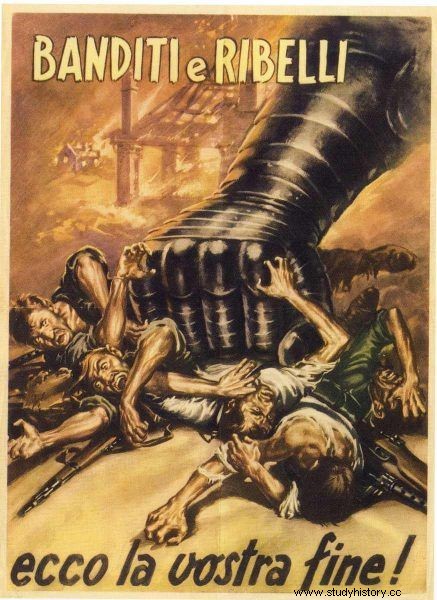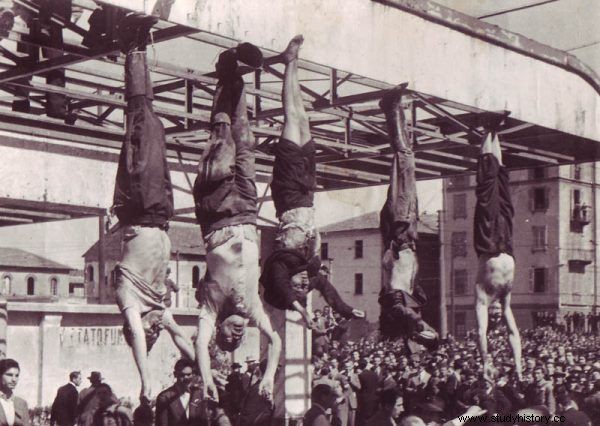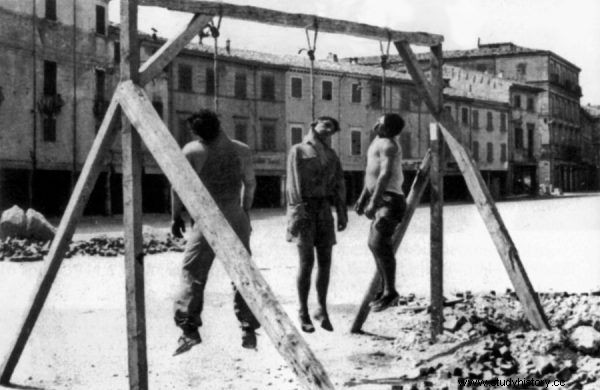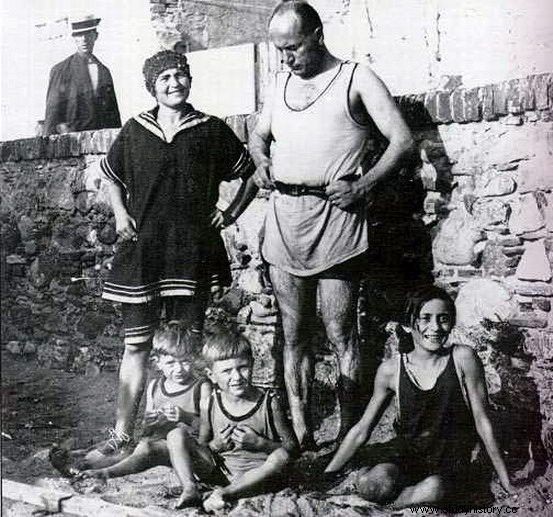Street round-ups, mass executions, dead bodies littering the streets. Fascists have paid a heavy price for more than 20 years of their rule. Their leader was shot and his body, exposed to the public, profaned by an angry crowd. Up to 20,000 members and supporters of the fascist party could have died with him.
Italy at the end of World War II was divided not only by the front line, but also politically. The north of the country was occupied by the Germans, and the south was occupied by the Allies. On one side of the barricade stood the fascists, led by Mussolini, on the other, the opposition, among which the communist guerrillas played a significant role.
Mussolini's time was running out, both due to the advances of the Allied forces and the actions of the Italian partisans. In this situation, Duce, through Cardinal Ildefonso Schuster, entered into negotiations with representatives of the Italian resistance movement. However, the talks ended in a fiasco.
On April 24, 1945, the Italian Committee for National Liberation called for a nationwide uprising to liberate parts of the country still under German occupation. There were attacks on enemy columns, and on April 25, guerrillas liberated Milan.

Propaganda promised anti-fascist partisans to die under the blow of an iron fist. In 45, however, the roles were reversed.
The fascist dictator then got mad that, at the head of his loyal troops, he would fight the last battle with the Allies in the Valtellina valley, right on the border with Switzerland. This essentially suicide plan he also failed for a rather prosaic reason: he ran out of soldiers. Mussolini only had to escape .
Accompanied by a handful of devoted friends, including longtime mistress Clara Petacci, he has joined a small German squad to make its way to Switzerland. However, on April 27, the Wehrmacht vehicle column was stopped by Italian partisans. Duce, even though he was disguised as a German soldier, was immediately recognized by them.
Execution of the dictator
On April 28, Mussolini and Clara Petacci were taken from the mountain hideout by a man who introduced himself as Colonel Valerio. Supposedly he was supposed to come to their rescue. In fact, it was Walter Audisio, a communist guerrilla and staunch anti-fascist.
Audisio hurriedly packed Duce and his companion into the car. The car had not traveled more than a hundred meters when the driver stopped. He ordered the passengers to leave the vehicle and stand against the wall of the roadside villa. Audisio reloaded Sten and vaguely mumbled the words of the death sentence on behalf of the Italian people.

The bodies of Benito Mussolini (second from left), Clara Petacci and three prominent fascists hung at a gas station at Pizzale Loreto in Milan (photo:public domain)
The last moments of the life of the Italian dictator and his lover are described by Nicholas Best in the book "Five days that shook the world":
Sten jammed when Audisio tried to open fire. Cursing, Audisio pulled out his revolver, but it jammed as well. Seeing what was happening, Mussolini (...) opened the skirts of his coat, stood in front of Audis and provoked him to the worst.
- Shoot my chest, he said.
One of Audisio's men hurriedly handed him his gun. This time the shots were on target. The first bullets reached Clara Petacci, who died right away. Mussolini was thrown against the wall next to her and he fell to the ground, still alive. Audisio walked over and fired at him again up close. Mussolini twitched convulsively, then froze (…).

French MA38 submachine gun from which Mussolini was shot (photo:Sailko, CC BY-SA 4.0).
The same fate befell 15 other people captured along with Mussolini, including Alessandro Pavolini, secretary of the fascist party, four ministers, and some of Duce's closest friends.
The bodies of Mussolini and Clara Petacci were then taken secretly to Milan, where they were displayed to the public, hanging upside down in front of the gas station building on Pizzale Loreto. The bodies were desecrated by a crowd of revenge and so massacred that it was difficult to recognize them . Audisio himself almost paid for this trip with his life, when he and his men were mistaken for fascists by other partisans and placed against the wall.
Bloody days in Milan
Real Dante's scenes were taking place in Milan at that time. The already mentioned Nicholas Best continues:
It was then a killing orgy; fascists were arrested en masse and old scores were settled . Hundreds of people died and fights continued as rival groups struggled to take control of the city.

"The Three Martyrs" - partisans hanged in Rimini in 1945. The memory of fascist violence prompted brutal retaliation (photo:public domain).
This state of affairs was confirmed by General Willis Crittenberger of the American IV Corps, who found complete chaos there. Human bodies were found throughout the city, often without any objects or documents allowing their subsequent identification. The British ambassador summed it up as follows:
It is therefore difficult to say whether the victims are fascists shot by partisans, partisans liquidated by fascists, or whether they are victims of personal reckoning.
As calculated by the British services, from the liberation of Milan on April 25 to May 9, 1945, at least 5,000 were "lost" in the city. people. And this is certainly an underestimated figure.
Justice according to the Italian partisans
All northern Italy has plunged into a frenzy of bloody vengeance . The greatest number of acts of violence against fascists took place in the regions of Piedmont, Emilia Romagna and Veneto. At least 1,000 people were killed in Turin alone. Death happened not only to members of the Republican Fascist Party, but even to those who were suspected of being related to it in any way, such as employees of the state administration.

Pier Luigi Bellini delle Stelle, commander of the partisan detachment who captured Mussolini (Photo:Public Domain).
Most often they were sudden, in emotion. Others were more organized, because there were also partisan groups that were looking for specific, previously selected people . Even ad hoc, improvised courts were created, after which the convict stood before the firing squad.

Mussolini with his wife and children in 1923. In the spring of 1945, Rachel escaped her husband's fate, but had to hide from anti-fascist partisans and militants (photo:public domain).
These executions were mentioned by Rachele Mussolini, the dictator's wife, held in a prison in Como, whose account is quoted by Nicholas Best in "Five Days That Shook the World":
We heard something from what was happening outside. Someone in the courtyard read the names from the list, then there was a burst of machine guns, followed by the pounding of the wagon's wheels. It happened over and over and lasted all night.
Crime and Punishment
The Allied authorities seemed surprised at this turn of events and in fact did nothing to prevent bloodshed . Moreover, in some parts of Italy, guerrillas were given explicit permission on this type of action from officers of the allied countries.
This was the case in Turin, for example, where Colonel John Stevens informed the local resistance commander: Look, Mr. Chairman, get things done in two or three days, but on the third day I don't want to see dead bodies on the streets.
Retaliation did not stop with the end of the war. Partisans clearly did not believe in the Italian judiciary, in which, despite the overthrow of fascism, high positions were still held by the functionaries of the overthrown regime. Situations were common when after the conviction of fascist criminals, their sentences were annulled by the Italian Supreme Court - Court of Cassation.

Anti-fascist partisans during the parade after the liberation of Bologna in April 1945 (photo:public domain).
No wonder the militants continued to take matters into their own hands. They even went so far as to break into the prison in Schio in the province of Vicenza and murder 55 detainees there . As the participant of this action stated after many years: for me, the fact that they had been killed was an act of justice .
Scale of retaliation
We will probably never know how many fascists and collaborators or suspected collaborators were killed during the purges described. The number of victims is estimated at approximately 12,000 to 20,000 American historian Frank Joseph writes about 300,000. murdered, which seems to be greatly exaggerated. One thing is certain:in no other European country has there been such a scale of retaliation. As Keith Lowe calculated it:
For every 100,000 people in a given country, only one collaborator suspect was killed in the Netherlands, more than three in Belgium, more than twenty-two in France, and twenty-two in Italy six to forty-four.

Monument to the guerrilla in Arcevia (photo:Claudio.stanco, CC0 1.0 Universal Public Domain Dedication).
It is also worth citing other data that may justify some of the actions of the Italian partisans. Until 1946, Italian courts conducted proceedings against 394,000 state administration employees. From this number 1,580 people were dismissed, most of whom returned to their previously held positions .
In turn, for 50 thousand. of arrested fascists, only a small part of them received prison sentences. Moreover, an amnesty was soon announced for those sentenced to less than five years in prison, and they were released. So it is hard to say that the Italian romance with fascism has been fairly judged.
